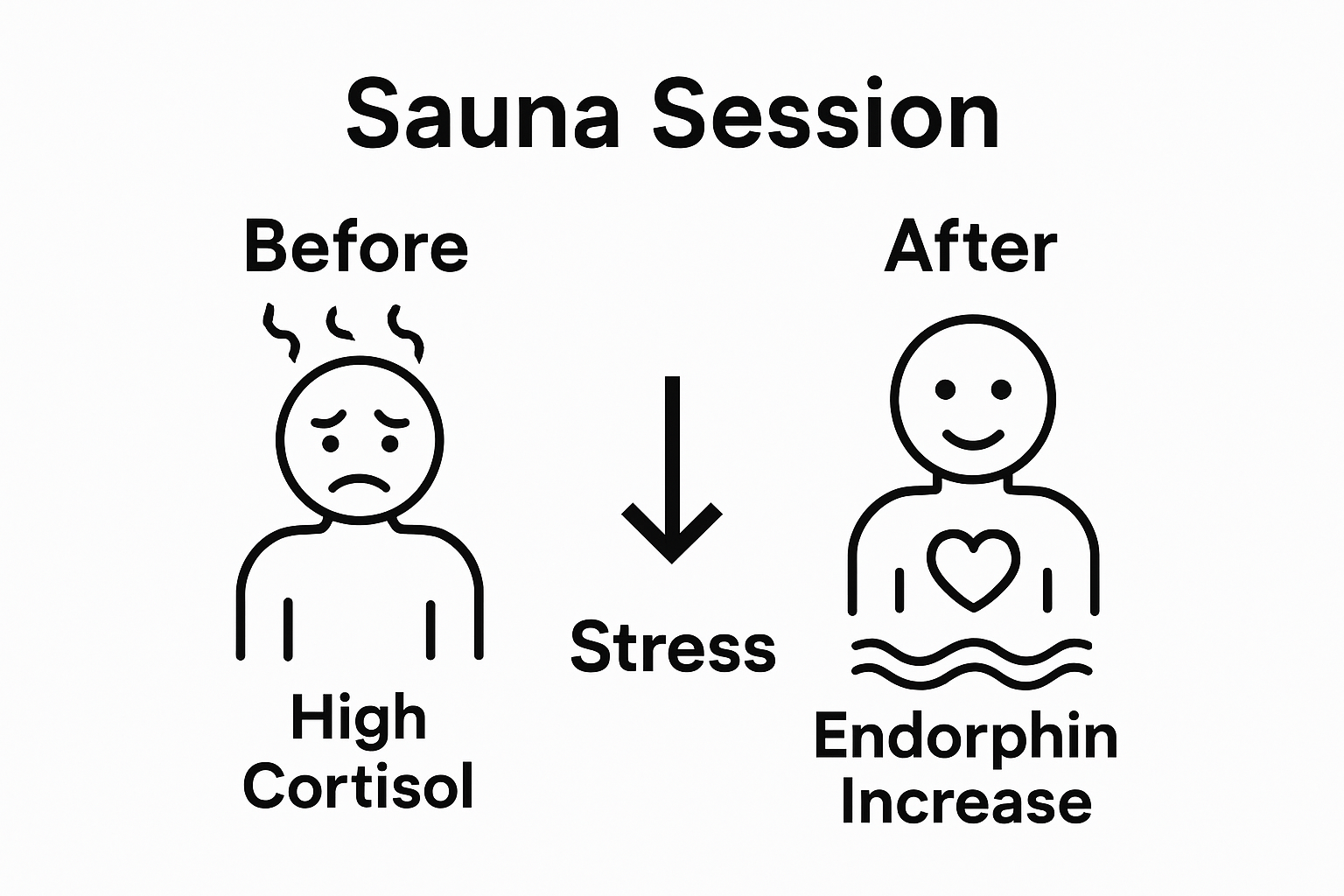
Understanding Sauna Therapy for Stress Relief
Sauna therapy sounds like an old-world spa ritual, but modern science is catching up fast. Imagine stepping into a steam-filled room and triggering a cascade that actually reduces stress hormones and improves heart health. According to research, regular sauna use can significantly decrease symptoms of anxiety and depression, and lower cortisol levels. Surprisingly, the real secret of sauna therapy is not just relaxation. It is that controlled heat stress transforms the body’s natural ability to handle both physical and mental stress, setting the stage for deeper well-being.
Table of Contents
- What Is Sauna Therapy And Its Purpose
- The Science Behind Sauna Therapy And Stress Relief
- Benefits Of Sauna Therapy For Mental And Physical Health
- How Sauna Sessions Impact Stress Levels
- Real-Life Applications And Experiences With Sauna Therapy
Quick Summary
| Takeaway | Explanation |
|---|---|
| Induces Stress Relief | Sauna therapy reduces cortisol levels, aiding stress management through hormonal balance. |
| Enhances Cardiovascular Health | Heat exposure increases heart rate and circulation, simulating the benefits of moderate exercise. |
| Improves Mental Well-Being | Regular sauna use boosts mood and emotional regulation, helping to alleviate anxiety and depression symptoms. |
| Facilitates Muscle Recovery | The heat exposure accelerates post-exercise recovery, reducing soreness and inflammation in muscles. |
| Promotes Overall Well-Being | Sauna therapy encourages holistic health by stimulating immune function, enhancing resilience, and improving sleep. |
What is Sauna Therapy and Its Purpose
Sauna therapy is a wellness practice involving controlled heat exposure designed to promote physical and mental relaxation. This therapeutic technique uses high-temperature environments to trigger multiple physiological responses that contribute to overall health and stress reduction.
Understanding the Core Concept
At its foundation, sauna therapy involves sitting in a heated room or enclosed space typically maintained between 150 to 195 degrees Fahrenheit. The primary goal is to induce sweating and elevate core body temperature in a controlled, safe manner. Unlike casual heat exposure, sauna therapy is a structured approach to wellness that leverages specific temperature ranges and duration to maximize potential health benefits.
According to scientific research from the National Institutes of Health, sauna therapy works by stimulating the body’s natural healing mechanisms. When exposed to intense heat, the body responds by:
- Increasing circulation and blood flow
- Releasing endorphins that promote relaxation
- Triggering a mild cardiovascular workout
- Reducing muscle tension
- Potentially lowering stress hormone levels
Physiological Mechanisms of Sauna Therapy
The human body responds to sauna heat through complex physiological processes. When you enter a sauna, your skin temperature rapidly rises, causing blood vessels to dilate. This vasodilation increases heart rate and improves overall circulation, similar to moderate cardiovascular exercise. The controlled heat stress triggers a thermoregulatory response, which means your body works to maintain its core temperature through sweating and increased metabolic activity.
Moreover, the heat exposure activates heat shock proteins, molecular chaperones that help protect cells from stress and potential damage. These proteins play a crucial role in cellular repair and can contribute to improved resilience against environmental and physical stressors. By deliberately subjecting the body to controlled heat stress, sauna therapy essentially trains the body to become more adaptable and efficient in managing physiological challenges.
Below is a concise table summarizing the physiological processes and their stress relief impacts described during sauna therapy.
| Physiological Process | Description | Stress Relief Impact |
|---|---|---|
| Vasodilation | Blood vessels widen, increasing blood flow and circulation | Promotes relaxation, lowers blood pressure |
| Heat Shock Protein Activation | Proteins that help protect cells from stress and damage are activated | Improves resilience to physical stress |
| Endorphin Release | Production of body’s natural \ |
The Science Behind Sauna Therapy and Stress Relief
Sauna therapy represents a sophisticated approach to stress management rooted in complex physiological mechanisms that interact with the human body’s natural stress response systems. By understanding the scientific principles underlying heat exposure, we can appreciate how this ancient practice provides modern wellness benefits.
Neurochemical and Hormonal Responses
When exposed to sauna heat, the body initiates a series of intricate neurochemical and hormonal changes. Cortisol reduction becomes a primary mechanism for stress relief. The controlled heat environment triggers the hypothalamic-pituitary-adrenal (HPA) axis, which plays a critical role in modulating stress responses. Research from the Mayo Clinic Proceedings indicates that regular sauna sessions can significantly impact the body’s stress management capabilities.
The physiological responses during sauna therapy include:
- Decreased production of stress hormones
- Enhanced endorphin release
- Improved autonomic nervous system balance
- Reduction in overall sympathetic nervous system activation
- Promotion of parasympathetic relaxation states
Cardiovascular and Autonomic Nervous System Modulation
Sauna therapy induces a unique cardiovascular response similar to moderate exercise. The heat causes blood vessels to dilate, increasing heart rate and improving circulation. This process stimulates cardiovascular conditioning and helps reset the body’s stress response mechanisms. By repeatedly exposing the body to controlled heat stress, individuals can potentially improve their physiological resilience and stress adaptation capabilities.
The autonomic nervous system experiences significant modulation during sauna sessions. Heart rate variability changes indicate a shift from sympathetic (fight or flight) to parasympathetic (rest and digest) dominance. This transition is crucial for effective stress management, as it allows the body to transition from a state of heightened alertness to a more relaxed, balanced condition. Through consistent practice, sauna therapy can help individuals develop more robust stress management strategies and improve overall psychological well-being.
Benefits of Sauna Therapy for Mental and Physical Health
Sauna therapy extends far beyond simple relaxation, offering a comprehensive approach to wellness that positively impacts both mental and physical health. By engaging multiple bodily systems simultaneously, this therapeutic practice provides a holistic method for improving overall well-being and resilience.
Mental Health and Psychological Benefits
The psychological advantages of sauna therapy are profound and multifaceted. Regular heat exposure has been linked to significant improvements in mood, stress management, and emotional regulation. Research published in Evidence-Based Complementary and Alternative Medicine demonstrates that consistent sauna use can effectively reduce symptoms associated with anxiety and depression.
Key psychological benefits include:
- Enhanced emotional regulation
- Increased production of endorphins
- Improved sleep quality
- Reduced perceived stress levels
- Greater overall sense of mental calm
Physical Health and Systemic Wellness
Beyond mental health benefits, sauna therapy triggers remarkable physiological responses that contribute to comprehensive physical wellness. The intense heat environment stimulates cardiovascular function, boosts immune system performance, and supports metabolic processes. Blood circulation improves dramatically during sessions, helping to flush toxins, deliver nutrients more efficiently, and support cellular regeneration.
Physiological advantages encompass more than immediate responses. The controlled heat stress essentially acts as a form of mild hormetic conditioning, where brief exposure to challenging environmental conditions strengthens the body’s adaptive mechanisms. This process can potentially enhance overall resilience, improve muscle recovery, support weight management, and contribute to long-term metabolic health. Regular practitioners often report increased energy levels, better immune function, and a more robust physiological response to environmental stressors.
To help you scan the main psychological and physical benefits of sauna therapy discussed in this section, see the organized summary below.
| Benefit Type | Key Effects |
|---|---|
| Mental | Reduced anxiety and depression symptoms, improved mood, better sleep |
| Physical | Enhanced cardiovascular function, muscle recovery, immune support |
| Systemic | Improved stress resilience, toxin elimination, metabolic support |
| Emotional | Greater emotional regulation, mental calm, lower perceived stress |
| Sleep | Better sleep quality, relaxation before bedtime |
How Sauna Sessions Impact Stress Levels
Sauna therapy offers a sophisticated and scientifically validated approach to stress management, transforming how the body processes and responds to psychological and physiological tension. By creating a controlled environment of intense heat, sauna sessions trigger complex neurological and hormonal mechanisms that directly counteract stress responses.
Neurohormonal Stress Reduction
Cortisol modulation represents a primary mechanism through which sauna therapy mitigates stress. When exposed to heat, the body initiates a cascade of neurochemical responses that help reset the stress response system. Research from Evidence-Based Complementary and Alternative Medicine demonstrates that regular sauna use can significantly alter stress hormone production and perception.
Key neurohormonal stress reduction processes include:
- Immediate reduction in circulating stress hormones
- Activation of endorphin release mechanisms
- Suppression of sympathetic nervous system activity
- Enhanced parasympathetic nervous system engagement
- Improved neuroendocrine system regulation
Autonomic Nervous System Recalibration
Sauna sessions profoundly influence the autonomic nervous system, which governs involuntary physiological processes related to stress management. The intense heat environment creates a controlled stress scenario that helps train the body’s stress response mechanisms. By repeatedly exposing the body to heat-induced physiological challenge, individuals can develop greater resilience and adaptability.
The thermal stress experienced during sauna therapy acts as a form of controlled exposure therapy. This process helps recalibrate the body’s stress response, teaching the nervous system to transition more efficiently between activated and relaxed states. Over time, regular sauna practitioners often report improved emotional regulation, decreased anxiety sensitivity, and a more balanced overall stress response. The cumulative effect is a more robust psychological and physiological approach to managing daily stressors.
This table contrasts the neurohormonal and autonomic nervous system mechanisms through which sauna sessions lower stress, as explained in the corresponding content.
| Stress Relief Mechanism | Description | Example Outcomes |
|---|---|---|
| Cortisol Modulation | Alters production of stress hormones in response to heat exposure | Reduced circulating cortisol |
| Endorphin Release | Boosts natural feel-good chemicals for relaxation | Elevated mood, pain relief |
| Sympathetic Nervous System Suppression | Decreases 'fight or flight' stress activation | Lower anxiety, relaxed state |
| Parasympathetic Engagement | Increases 'rest and digest' nervous activity | Greater calm, less perceived stress |
| Neuroendocrine Regulation | Resets stress response systems for improved balance | More adaptive responses to daily stressors |

Real-Life Applications and Experiences with Sauna Therapy
Sauna therapy transcends theoretical research, offering tangible benefits across diverse populations and lifestyle contexts. From athletes seeking recovery to professionals managing chronic stress, individuals are discovering personalized approaches to integrating heat therapy into their wellness routines.
Performance and Recovery Strategies
Athletic performance enhancement represents a significant real-world application of sauna therapy. Professional athletes and fitness enthusiasts utilize heat exposure as a strategic recovery and conditioning method. Research from the Journal of Exercise Rehabilitation demonstrates how thermal stress can positively influence physiological adaptation and muscle recovery processes.
Key performance and recovery applications include:
- Accelerated muscle recovery post intense training
- Enhanced cardiovascular conditioning
- Improved heat tolerance and adaptability
- Reduced muscle soreness and inflammation
- Potential increases in growth hormone production
Stress Management and Lifestyle Integration
Beyond athletic contexts, sauna therapy has emerged as a powerful tool for urban professionals and individuals managing high-stress environments. The deliberate practice of heat exposure provides a structured opportunity for mental reset and physiological recalibration. Regular sauna sessions offer a dedicated space for disconnecting from digital stimuli and reconnecting with bodily sensations.
Individuals report experiencing profound mental benefits, including improved sleep quality, reduced anxiety, and enhanced emotional resilience. The meditative environment of a sauna creates a unique opportunity for mindfulness practice, allowing practitioners to develop greater self-awareness and stress management capabilities. By transforming a seemingly simple heat exposure into a intentional wellness ritual, people are discovering a holistic approach to managing modern life’s complex psychological demands.

Discover Real Stress Relief with Premium Sauna Solutions
Are you ready to move from reading about the science of stress reduction to experiencing it in your own home? If the idea of regulating your stress response, promoting relaxation, and managing daily tension resonated with you in the article, it is time to turn knowledge into action. Unlock the real potential of sauna therapy by choosing high-quality systems designed specifically for wellness seekers. Explore Best Life Sauna to find tailored options such as infrared, traditional, and outdoor saunas that can support your journey toward mental clarity and physical vitality every day.

Start creating your personalized sanctuary today. Visit our home page to browse the latest wellness solutions. Take advantage of free shipping on orders over $200, customer-approved support, and exceptional value with our price match guarantee. Embrace the proven benefits of sauna therapy for stress relief right now. Your wellness upgrade starts here.
Frequently Asked Questions
What is sauna therapy?
Sauna therapy is a wellness practice that involves controlled heat exposure in a heated room, typically ranging from 150 to 195 degrees Fahrenheit, aimed at promoting relaxation, reducing stress, and improving overall health.
How does sauna therapy help alleviate stress?
Sauna therapy reduces stress by modulating cortisol levels and promoting the release of endorphins, which enhances mood and relaxation. The heat exposure also helps recalibrate the autonomic nervous system, allowing for better management of stress responses.
What are the key health benefits of sauna therapy?
The key health benefits of sauna therapy include improved cardiovascular function, enhanced muscle recovery, reduction in symptoms of anxiety and depression, better sleep quality, and an overall boost in mental and physical well-being.
How often should I use the sauna for optimal stress relief?
For optimal stress relief, it is generally recommended to use the sauna 1 to 3 times a week. However, the frequency can vary based on individual health conditions and wellness goals; it’s best to start slowly and consult with a healthcare provider if needed.

